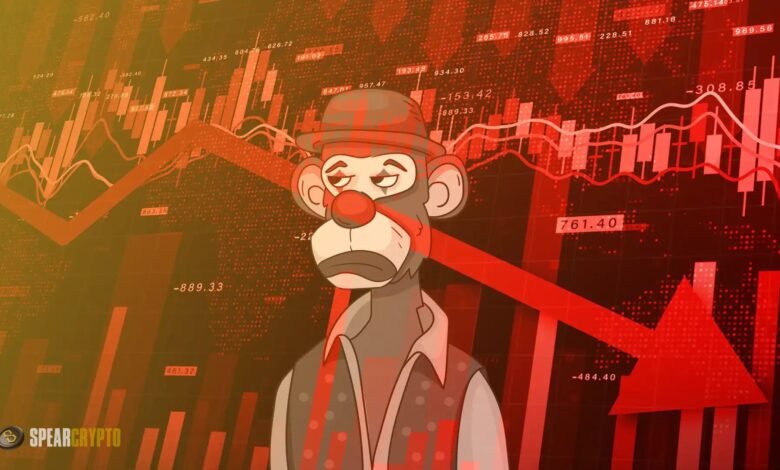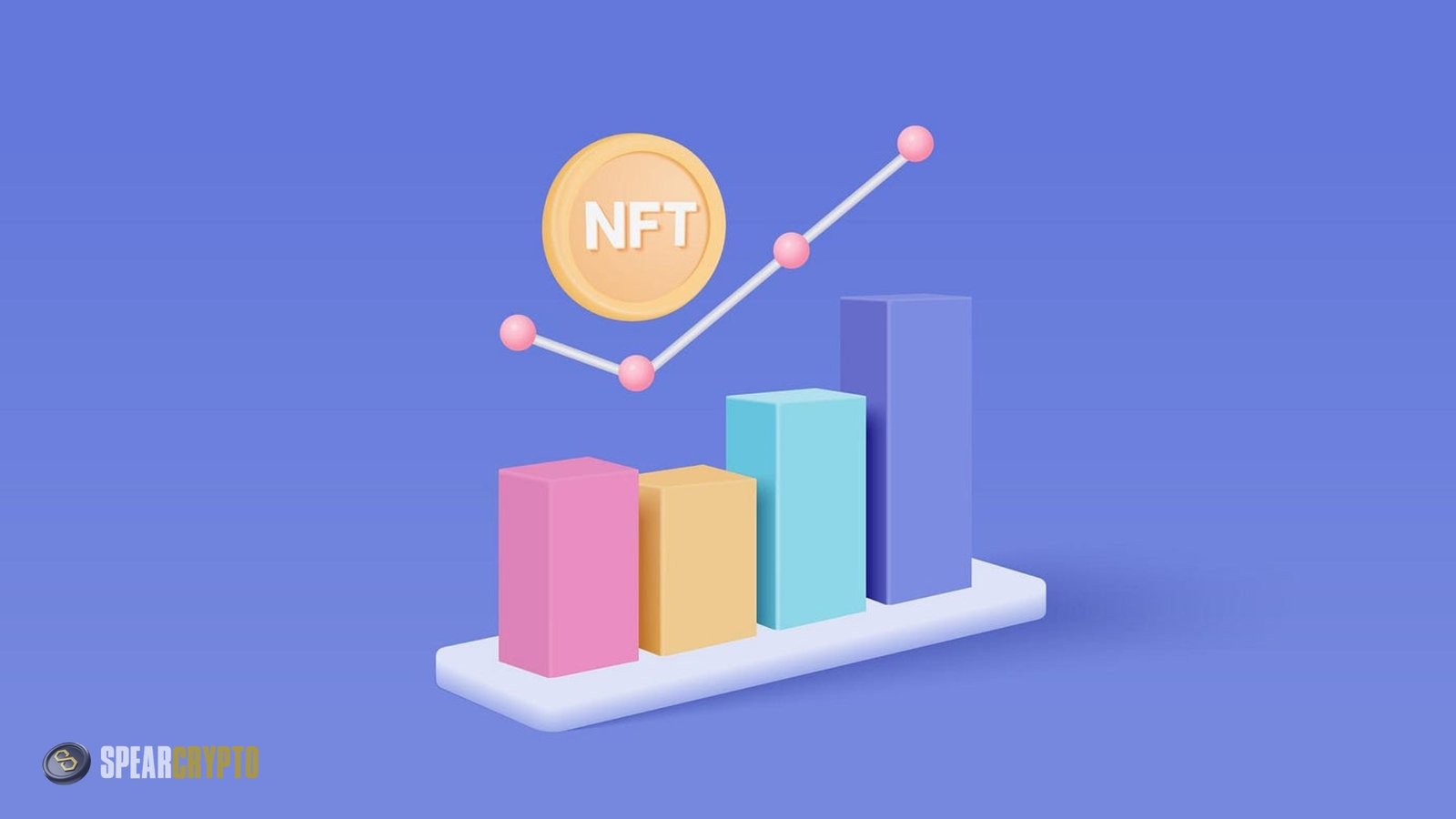
There has been a dramatic decline in the Non-Fungible Token (NFT) market, formerly a model of how art, technology, and cryptocurrencies might work together. The unique digital goods like artwork, music, and collectibles that NFTs were able to sell in 2021—which garnered a lot of attention—have since seen a steep fall in trading volume, value, and interest. Once teeming with optimism and record-high values, the market is experiencing a severe “crash.” Learn more about the causes of the NFT market crash, its wider effects, and NFTs’ potential future in this in-depth essay.
The Meteoric Rise of NFTs
We must examine the rise of NFTs worldwide to comprehend the crash. NFTs stand for ownership of digital or physical assets and are distinct cryptographic tokens that exist on blockchain networks, the most popular of which is Ethereum. The surge was set in motion by prominent sales, such as Beeple’s “Everydays: The First 5000 Days,” which fetched $69 million in early 2021 at Christie’s auction house. The market became a frenzy as celebrities, artists, and companies leaped on the NFT bandwagon.
The NFT market experienced tremendous growth in 2020 and 2021. NFT sales skyrocketed from $95 million in 2020 to over $24 billion in 2021, according to DappRadar. Several factors contributed to this quick expansion:
- It increased mainstream adoption due to high-profile sales and celebrity endorsements.
- The rise of decentralized finance (DeFi) and the broader cryptocurrency boom.
- The growing interest in metaverse platforms and digital ownership.
Many people saw NFTs as a way to acquire digital commodities and artwork in a new way, with the potential for users to own rare digital items and producers to earn more money.
Signs of Trouble: The Beginning of the Decline
The NFT market started to exhibit signs of weakness in the middle of 2022. Despite the market’s phenomenal gains, it become more unpredictable. Several things came together to cause the crash to happen:
Market Saturation and Overvaluation
Thousands of projects flooded the market with new content as the NFT frenzy expanded. The release of NFTs was widespread, including artists, brands, and businesses with no prior ties to the digital art scene. The result of this surplus was a saturated market. Not every digital product is worth millions, as investors and collectors started to discover when they first saw NFTs as rare, valuable goods. The NFT bubble burst because many projects were speculative with no real practical or inherent worth.
Declining Crypto Markets
In the Bitcoin ecosystem, NFTs play a key role. It is common practice to purchase and sell NFTs on Ethereum, the blockchain that facilitates most NFT transactions. The NFT market collapsed in 2022, along with the rest of the cryptocurrency sector, which saw massive price drops for Ethereum and Bitcoin. When the value of cryptocurrencies fell, so did the value of NFTs because they are pegged to those currencies.
Rising Interest Rates and Economic Downturn
The NFT crash was caused in part by the larger macroeconomic climate. Central institutions, including the Federal Reserve, increased interest rates in 2022 to curb inflation. Investors’ risk tolerance plummeted, and they shied away from speculative assets like NFTs and cryptocurrencies. People were already careful with spending and investments before the economic slump hit.
Scams, Fraud, and Regulatory Uncertainty
The NFT market’s meteoric rise also drew unscrupulous players. People lost faith in the industry as scams, rug pulls, and fake ventures proliferated. Governments worldwide are debating possible frameworks to control digital assets, adding uncertainty to the regulatory landscape surrounding NFTs. Mainstream investors were already wary of crackdowns or legal challenges, which made their fears worse.
The Numbers: Quantifying the NFT Crash
The severity of the NFT market collapse was revealed in the middle of 2023. Data from many analytics platforms revealed a precipitous sales and trade volume drop. The average daily trading volume of NFTs decreased by more than 90% compared to the market peak in 2021, according to NonFungible.com. The once-billion-dollar overall value of NFT transactions dropped significantly.
When prominent collections like Bored Ape Yacht Club (BAYC) and CryptoPunks saw their floor prices decline, it clearly indicated the NFT slump. As a status symbol in 2021, having an NFT from one of these collections may fetch several million dollars. Nevertheless, in 2023, there was a 70% decline in the floor pricing of these collections, indicating a decrease in demand and interest in the NFT market.
The Impact on Artists, Investors, and Platforms
Everyone from artists and collectors to markets and financiers has felt the effects of the NFT crisis.
Creators and Artists
Natural tokens were a game-changer for many artists looking to make money from their digital work. In the early days of the boom, several independent creators achieved enormous success, selling their work for previously unfathomable prices. And yet, many creative types have found it difficult to make a living after the disaster. Due to market saturation and a general downturn in interest, NFTs are only profitable for a select group of well-known artists, while smaller creators see their earnings dwindle.
Collectors and Investors
Many people’s investments had diminished since they got in at the height of the NFT boom when they thought they might make a fast buck. After investing in NFTs on the speculative belief that their value would rise, many people saw their digital assets plummet as the market crashed. Some collectors have decided to stay in the market and lose a lot of money, while others have decided to keep onto their NFTs for the long haul, hoping the market will rebound.
NFT Marketplaces
Also hit hard by the downturn are platforms like OpenSea, Rarible, and Foundation, which rose to prominence during the NFT boom. For example, OpenSea had to trim costs in 2022 by laying off some employees due to a steep drop in trade volume. The absence of activity and customer involvement has caused several smaller marketplaces to switch to alternative business models or permanently close their doors.
The Future of NFTs: Is There a Path to Recovery?
Despite the devastating loss in value of NFTs, many are optimistic about the future of the technology underlying them. Some think the recession is good because it will expose fraudulent and speculative ventures, clearing the way for more legitimate and long-term innovations.
Utility-Based NFTs
Many NFTs had little practical use, which was a major complaint leveled against the early NFT market. They weren’t seen as practical goods but as assets for speculation. On the other hand, utility-based NFTs might become more popular in the future. Among these, you may find:
- Gaming NFTs: In-game items, characters, or virtual land that can be owned and traded by players, allowing for more meaningful digital ownership.
- Membership and Access Tokens: NFTs that grant access to exclusive content, events, or communities could provide lasting value beyond speculation.
- Real-World Asset Representation: NFTs could represent ownership of physical assets, such as real estate, or certify the authenticity of physical goods like luxury items.
Integration with the Metaverse
As the metaverse, a shared virtual environment for groups of people, evolves further, NFTs will likely become more important to its financial system. A new growth opportunity for NFTs may arise if the value of digital real estate, virtual products, and collectibles increases due to the increasing popularity of the metaverse.
Increased Regulation and Security
Due to the absence of oversight, the NFT market has become a breeding ground for con artists. On the other hand, rules to safeguard investors and users may be introduced in response to authorities’ heightened scrutiny. The NFT space may gain credibility with stricter restrictions, which might entice institutional investors who were wary before.
Blockchain Advancements
New and developing blockchain technology may resolve some of the environmental and scalability issues that have affected NFTs. One example is how Ethereum 2.0’s shift to a proof-of-stake consensus mechanism greatly cut energy consumption, making NFTs more environmentally friendly. The efficiency, speed, and low cost of NFT transactions might increase as blockchain technology develops.
Conclusion
For those who had faith in the revolutionary power of NFTs, the market meltdown has been a wake-up call. Although many investors lost money when the speculative bubble broke, the technology behind NFTs is still very promising. Gaming, entertainment, and real-world asset tokenization businesses will be potential long-term beneficiaries of NFTs once the market recovers from the 2021 speculative frenzy.
Those who can successfully navigate the current uncertainty in the NFT market will be well-positioned to take advantage of future opportunities. What happens next in the market for NFTs—how producers, platforms, and consumers handle it—will determine whether the space can return to its previous grandeur or shift its attention to practicality.
[sp_easyaccordion id=”2907″]







